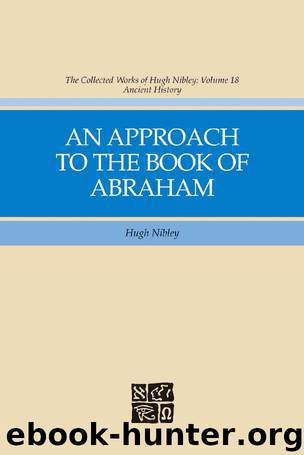Collected Works of Hugh Nibley, Vol. 18: An Approach to to the Book of Abraham by Hugh Nibley

Author:Hugh Nibley [Nibley, Hugh]
Language: eng
Format: epub
Publisher: Deseret Book Company
Published: 2016-11-01T06:00:00+00:00
Northern polar stars, 2000 B.C.
Figure 42. There was no bright star near the North Pole at this time, but nearby stars helped point to it. The four stars of the bowl of the Big Dipper were seen as the four sons of Horus.
Northern polar stars, A.D. 2000
In our time, Polaris is closest to the North Pole, but it is only a temporary honor. The North Pole will pass through every point on the large circle in its 26,000-year cycle, due to a change of the pointing angle of the earth’s axis known as the precession of the equinoxes.
Dick: What has this to do with the idolatrous god of Pharaoh?
Mr. Jones: As everyone knows, the Egyptians carried their cosmic imagery over into the affairs of earthly government —or vice versa. Whereas in Canaan, as Stadelmann has shown, there was “no fixed and established ‘Canaanite religion’” common to all the regions under Egypt, there was a single centralized Egyptian cult, centering in Pharaoh.605 The gods of Syria and Palestine are extremely hard to study, he says, because their relations to each other are “constantly changing from time to time and from place to place,”606 and though we know of their existence, we know almost nothing about their cults.607 The one thing that brings them together in a sort of order is “the dogmatic position of the Egyptian king as overlord of the Syro-Palestinian area.”608 And that is the situation we find in the explanation to Facsimile 1, where everything eventually comes back to Pharaoh and where “the idolatrous god of Pharaoh” (and we have seen that the crocodile was just that) takes his place among the Egyptianized gods of Canaan. This is a reminder that our lion-couch papyrus is a political as well as a religious document, and indeed the ancients never separated the two departments, least of all the Egyptians. This point is brought home with great force if we closely examine the next figure in the papyrus, which is figure 10: “Abraham in Egypt.”
Facsimile 1, Figure 10
Dick: If that’s Abraham, I’m Julius Caesar.
Mr. Jones: Hail, Caesar! Haven’t you learned yet that the Egyptians have their own special ways of indicating things? Notice how this same design is identified in figure 3 of Facsimile 3: “Signifies Abraham in Egypt.” It is not a portrait but a symbol, pure and simple. In all symbolism there are varying degrees of realistic representation, ranging from near portraits to pure abstraction. The Egyptian could give a reader a pretty good idea of a man on an altar, but how would he indicate a particular individual and no other on a particular altar in a particular country? For that he would either have to accompany his drawing by an explanatory text, as Abraham has done, or else show everything symbolically, which has been done in this case with considerable clarity and economy.
Dick: I don’t see it—Abraham in Egypt!
Mr. Jones: Of course you don’t. Even an Egyptian would not see it unless he had been initiated into
Download
This site does not store any files on its server. We only index and link to content provided by other sites. Please contact the content providers to delete copyright contents if any and email us, we'll remove relevant links or contents immediately.
The Aleppo Codex: A True Story of Obsession, Faith, and the Pursuit of an Ancient Bible by Matti Friedman(650)
Tower of Babel by Hodge Bodie(641)
Sarai by Smith Jill Eileen(563)
Zondervan Handbook of Biblical Archaeology: A Book by Book Guide to Archaeological Discoveries Related to the Bible by Price J. Randall & Price J. Randall & House H. Wayne & House H. Wayne(521)
Essential Judaism by George Robinson(484)
Food in Ancient Judah by Shafer-Elliott Cynthia(482)
Christian Faith in the Old Testament: The Bible of the Apostles by Gareth Lee Cockerill(476)
Essential Exposition of the Psalms by Saint Augustine(428)
Becoming the Woman God Wants Me to Be by Donna Partow(420)
On the Book of Psalms: Exploring the Prayers of Ancient Israel by Nahum M. Sarna(391)
A Short Introduction to the Hebrew Bible by John J. Collins(389)
The Beginning of Politics by Halbertal Moshe; Holmes Stephen;(381)
The Gospel According to Eve by Amanda W. Benckhuysen(362)
Beginning at Moses: A Guide to Finding Christ in the Old Testament by Michael P. V. Barrett(362)
Through the Psalms With Derek Prince by Derek Prince(358)
The Life of Moses by Gregory of Nyssa(340)
Six Themes in Psalms Everyone Should Know by Creach Jerome F. D.;(336)
The Essence of the Old Testament by Ed Hindson & Gary Yates(329)
Psalms and the Life of Faith by Walter Brueggemann(329)
